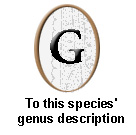

|
|
Description (from Seinhorst, 1959)
Cuticle marked by fine striae, about 1.5 um apart.
Lateral fields with 4 incisures. Lip region slightly set off from
body and bearing 3 annules. Lateral margins of cephalic framework
extending posteriorly for about half a body-annule. Spear 17 um
long. Dorsal oesophageal gland opening into lumen of the oesophagus
about 3 um from spear base. Excretory duct opening ventrally
at level of junction between oesophagus and intestine. Hemizonid
situated just anterior to this opening. Deirids not seen. Female
tail sometimes bluntly rounded and with striations around the tip as in
P.
pratensis but mostly more or less split into two irregular lobes.
Phasmids at middle of tail. The inner two incisures of the lateral
field go past the phasmid as in P. penetrans.
Ovary single, outstretched, with a single row of oocytes.
Spermatheca round. Uterus short. Postvulvar uterine sac extending
backwards 1.4-2 times the body width at the vulva and about as long as
the tail.
The male does not differ anatomically from the males of P.
penetrans.
Type host: Roots of Convallaria majalis.
Type locality: Wassenaar, Netherlands.
Relationships: The species resembles P. penetrans
most closely, in size and form. It differs from this species in the
tail tip being irregularly lobed and having incisures. The latter
are less regular than in P. pratensis from which species P. convallariae
is also different in having a spermatheca. P. convallariae
causes lesions in the root cortex of Convallaria majalis; in heavy attacks
the lesions may lead to a serious root rot. The species was also
found in sandy soil at Wageningen and Graveland (both in the Netherlands).
Description (from Loof, 1960)
Body moderately slender; long specimens were found
to be more slender than short ones. Body almost straight when killed
by gentle heat. Annulation of cuticle fine. Lateral field with
4 incisures, the outer ones weakly crenate, the inner ones amalgamating
at about level of phasmid. Lip region with 3 annules; outer angles
rounded. Labial framework as in P. penetrans. Stylet
knobs high and rather narrow, Hemizonid distinct.
Female: Ovary with oocytes in single row,
except for short zone near anterior end. Spermatheca round.
Posterior uterine branch a little over one body width long. Phasmid
about middle of tail, rather inconspicuous. Tail with coarsely, irregularly
annulated posterior edge, truncate in most specimens.
Male: Very similar to that of P. penetrans.
In some specimens the tail tip appeared bifid, in others the bursal edge
was slightly irregular immediately before the tail tip. Bursal edge
coarsely crenate. Testis shorter than vas deferens in the specimens
studied the demarcation between these two parts was more distinct than
in other species of Pratylenchus.
Diagnosis: P. convallariae resembles
P.
pratensis, P. crenatus and P. penetrans. From pratensis
it may be distinguished by the truncate tail and round spermatheca, from
the second by the presence of a spermatheca and numerous males, by the
weaker body annulation, 4 incisures in lateral field, more anterior position
of vulva, and tail shape; from P. penetrans by the annulated tail
tip and position of vulva. This last difference is small, but on
examination of 50 females of both species was found to be highly
significant (difference 6 times its standard error).
Distribution and hosts: P. convallariae
is known only from Convallaria, where it causes severe damage (Van
Poeteren, 1920). It has been reported from the Netherlands and from
Germany.
 |
 |